课堂翻译
- 格式:doc
- 大小:28.00 KB
- 文档页数:2
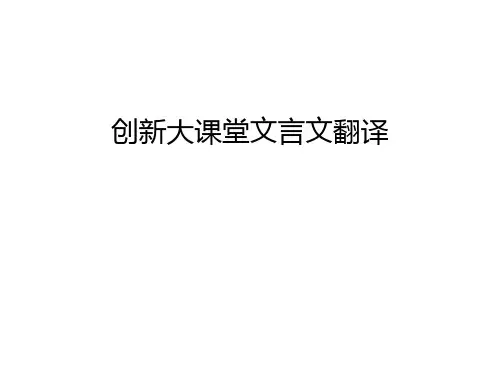
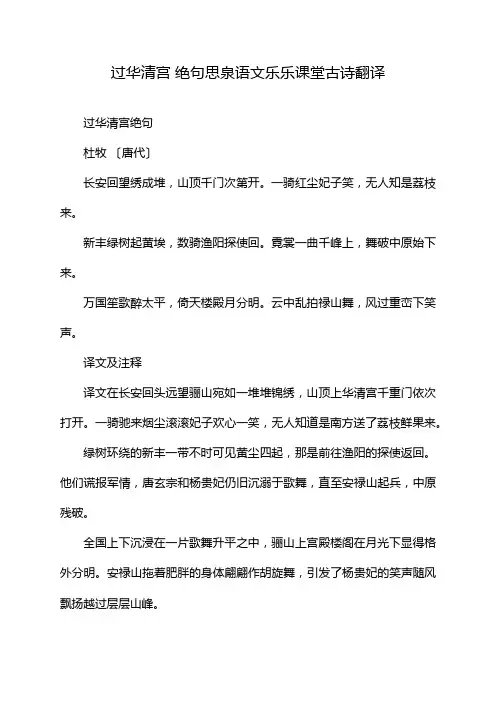
过华清宫绝句思泉语文乐乐课堂古诗翻译过华清宫绝句杜牧〔唐代〕长安回望绣成堆,山顶千门次第开。
一骑红尘妃子笑,无人知是荔枝来。
新丰绿树起黄埃,数骑渔阳探使回。
霓裳一曲千峰上,舞破中原始下来。
万国笙歌醉太平,倚天楼殿月分明。
云中乱拍禄山舞,风过重峦下笑声。
译文及注释译文在长安回头远望骊山宛如一堆堆锦绣,山顶上华清宫千重门依次打开。
一骑驰来烟尘滚滚妃子欢心一笑,无人知道是南方送了荔枝鲜果来。
绿树环绕的新丰一带不时可见黄尘四起,那是前往渔阳的探使返回。
他们谎报军情,唐玄宗和杨贵妃仍旧沉溺于歌舞,直至安禄山起兵,中原残破。
全国上下沉浸在一片歌舞升平之中,骊山上宫殿楼阁在月光下显得格外分明。
安禄山拖着肥胖的身体翩翩作胡旋舞,引发了杨贵妃的笑声随风飘扬越过层层山峰。
注释华清宫:《元和郡县志》:“华清宫在骊山上,开元十一年初置温泉宫。
天宝六年改为华清宫。
又造长生殿,名为集灵台,以祀神也。
”绣成堆:骊山右侧有东绣岭,左侧有西绣岭。
唐玄宗在岭上广种林木花卉,郁郁葱葱。
千门:形容山顶宫殿壮丽,门户众多。
次第:依次。
红尘:这里指飞扬的尘土。
妃子:指杨贵妃。
乐史《杨太真外传》:上曰:“赏名花,对妃子,焉用旧乐词!”《新唐书·李贵妃传》:“妃嗜荔枝,必欲生致之,乃置骑传送,走数千里,味未变已至京师。
”《唐国史补》:“杨贵妃生于蜀,好食荔枝,南海所生,尤胜蜀者,故每岁飞驰以进。
然方暑而熟,经宿则败,后人皆不知之。
”按:此诗或为写意之作,意在讽刺玄宗宠妃之事,不可一一求诸史实。
在唐代,岭南荔枝无法运到长安一带,故自苏轼即言“此时荔枝自涪州致之,非岭南也”(《通鉴唐纪》注)。
而荔枝成熟的季节,玄宗和贵妃必不在骊山。
玄宗每年冬十月进驻华清宫,次年春即回长安。
《程氏考古编》亦辨其谬,近人陈寅恪亦复考证之。
知是:一作“知道”。
新丰:唐设新丰县,在陕西临潼县东北,离华清宫不远。
黄埃:马队奔驰踏起的尘土。
渔阳探使:《全唐诗》此句下注:“帝使中使辅璆琳探禄山反否,璆琳受禄山金,言禄山不反。
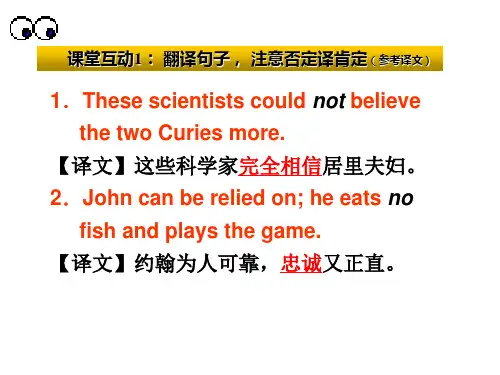
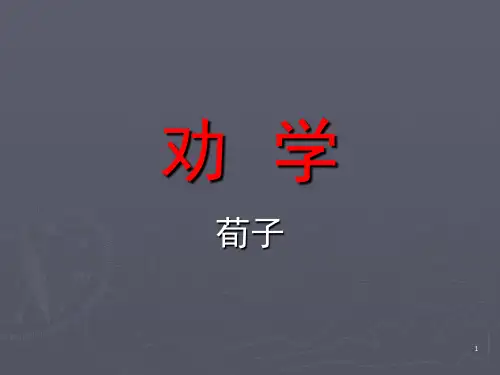
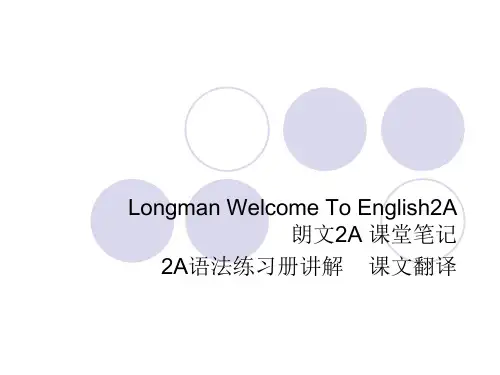
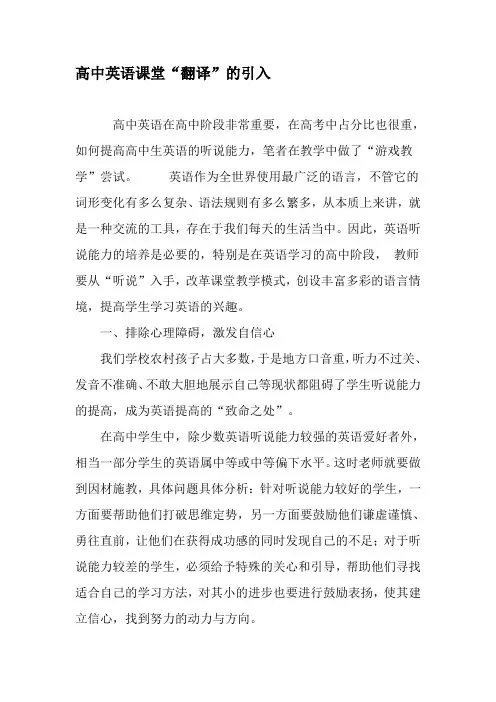
高中英语课堂“翻译”的引入高中英语在高中阶段非常重要,在高考中占分比也很重,如何提高高中生英语的听说能力,笔者在教学中做了“游戏教学”尝试。
英语作为全世界使用最广泛的语言,不管它的词形变化有多么复杂、语法规则有多么繁多,从本质上来讲,就是一种交流的工具,存在于我们每天的生活当中。
因此,英语听说能力的培养是必要的,特别是在英语学习的高中阶段,教师要从“听说”入手,改革课堂教学模式,创设丰富多彩的语言情境,提高学生学习英语的兴趣。
一、排除心理障碍,激发自信心我们学校农村孩子占大多数,于是地方口音重,听力不过关、发音不准确、不敢大胆地展示自己等现状都阻碍了学生听说能力的提高,成为英语提高的“致命之处”。
在高中学生中,除少数英语听说能力较强的英语爱好者外,相当一部分学生的英语属中等或中等偏下水平。
这时老师就要做到因材施教,具体问题具体分析:针对听说能力较好的学生,一方面要帮助他们打破思维定势,另一方面要鼓励他们谦虚谨慎、勇往直前,让他们在获得成功感的同时发现自己的不足;对于听说能力较差的学生,必须给予特殊的关心和引导,帮助他们寻找适合自己的学习方法,对其小的进步也要进行鼓励表扬,使其建立信心,找到努力的动力与方向。
二、创造课堂环境,进行听、说训练1.让英语对话渗透整个课堂教学。
从第一节课起教师就要要求学生听的时候专心致志、手脑并用。
老师在课堂教学的各个环节中应尽量多使用英语,凡能以英语表达的,如讲解、练习、测试和安排、布置家庭作业以及奖励、评讲等,都尽量使用英语。
考虑到学生的生理、心理、英语语言能力的特点,使用的语言应简单易懂,例如“Stand up”、“Sit down”、“Listen to me carefully”、“Look at the blackboard”等课堂用语。
通过这样的听、说练习,不仅会使学生体会到能听懂英语的自豪感,而且还潜移默化地向学生渗透了学会听的目的。
随着学生英语水平的逐步提高,可适当用英语解释英语。
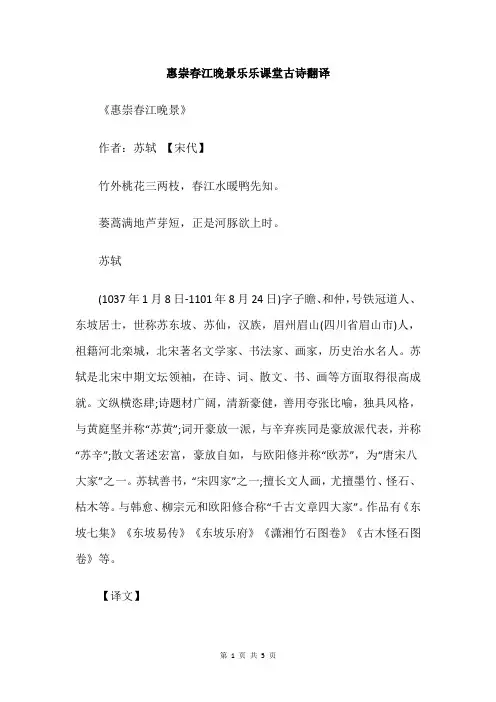
惠崇春江晚景乐乐课堂古诗翻译《惠崇春江晚景》作者:苏轼【宋代】竹外桃花三两枝,春江水暖鸭先知。
蒌蒿满地芦芽短,正是河豚欲上时。
苏轼(1037年1月8日-1101年8月24日)字子瞻、和仲,号铁冠道人、东坡居士,世称苏东坡、苏仙,汉族,眉州眉山(四川省眉山市)人,祖籍河北栾城,北宋著名文学家、书法家、画家,历史治水名人。
苏轼是北宋中期文坛领袖,在诗、词、散文、书、画等方面取得很高成就。
文纵横恣肆;诗题材广阔,清新豪健,善用夸张比喻,独具风格,与黄庭坚并称“苏黄”;词开豪放一派,与辛弃疾同是豪放派代表,并称“苏辛”;散文著述宏富,豪放自如,与欧阳修并称“欧苏”,为“唐宋八大家”之一。
苏轼善书,“宋四家”之一;擅长文人画,尤擅墨竹、怪石、枯木等。
与韩愈、柳宗元和欧阳修合称“千古文章四大家”。
作品有《东坡七集》《东坡易传》《东坡乐府》《潇湘竹石图卷》《古木怪石图卷》等。
【译文】竹林外两三枝桃花初放,鸭子在水中游戏,它们最先察觉了初春江水的回暖。
河滩上已经满是蒌蒿,芦笋也开始抽芽,而河豚此时正要逆流而上,从大海回游到江河里来了。
【注释】①惠崇:北宋大画家,建阳人。
《图绘玉鉴》说他最会画鹅、鸭、鹭鸶(lù sī)等小动物。
②春江晚景:惠崇画了两幅《春江晚景》,一幅是鸭戏图,一幅是飞雁图。
③蒌蒿(lóu hāo):多年生草本植物,花淡黄,茎可以食。
④芦芽:即芦笋,多年生草本植物,生在浅水里。
梅圣俞诗:“春洲生荻芽”,荻芽即芦芽。
⑤河豚(tún):鱼名,味鲜美,但含有毒汁。
⑥欲上:想浮上来。
春江水暖,河豚鱼就抢上水出游。
【赏析】诗的首句“竹外桃花三两枝”,隔着疏落的翠竹望去,几枝桃花摇曳身姿。
桃竹相衬,红绿掩映,春意格外惹人喜爱。
这虽然只是简单一句,却透出很多信息。
首先,它显示出竹林的稀疏,要是细密,就无法见到桃花了。
其次,它表明季节,点出了一个“早”字。
春寒刚过,还不是桃花怒放之时,但春天的无限生机和潜力,已经透露出来。
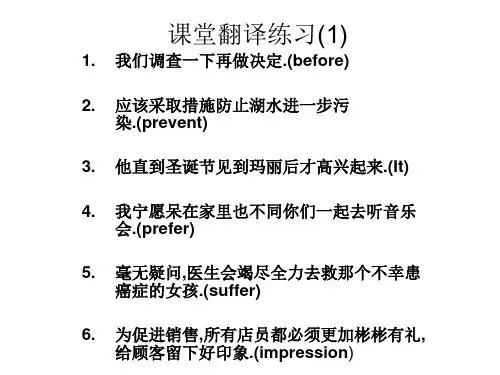
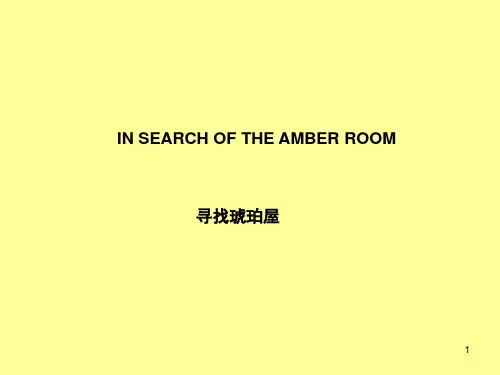
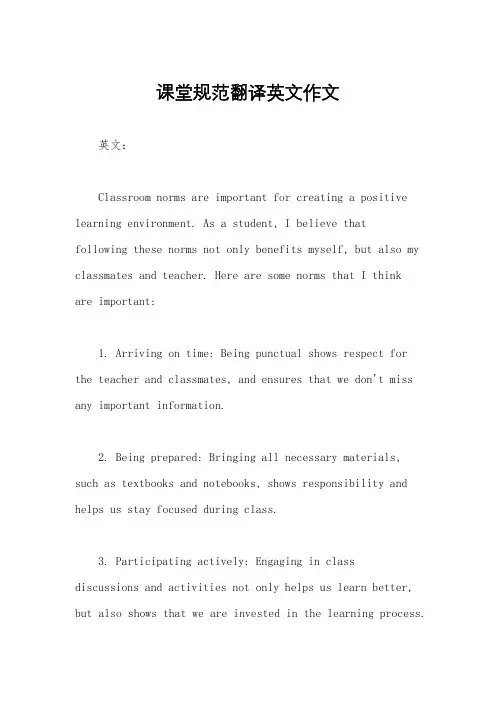
课堂规范翻译英文作文英文:Classroom norms are important for creating a positive learning environment. As a student, I believe thatfollowing these norms not only benefits myself, but also my classmates and teacher. Here are some norms that I thinkare important:1. Arriving on time: Being punctual shows respect forthe teacher and classmates, and ensures that we don't miss any important information.2. Being prepared: Bringing all necessary materials, such as textbooks and notebooks, shows responsibility and helps us stay focused during class.3. Participating actively: Engaging in classdiscussions and activities not only helps us learn better, but also shows that we are invested in the learning process.4. Respecting others: This includes not interrupting others, listening attentively, and refraining from negative comments or actions.5. Following instructions: Following the teacher's instructions helps maintain order and ensures that we areall on the same page.In addition to these norms, I think it's important tobe open-minded and respectful of different perspectives and opinions. This creates a welcoming and inclusive environment where everyone feels comfortable sharing their thoughts and ideas.中文:课堂规范对于创造积极的学习环境非常重要。
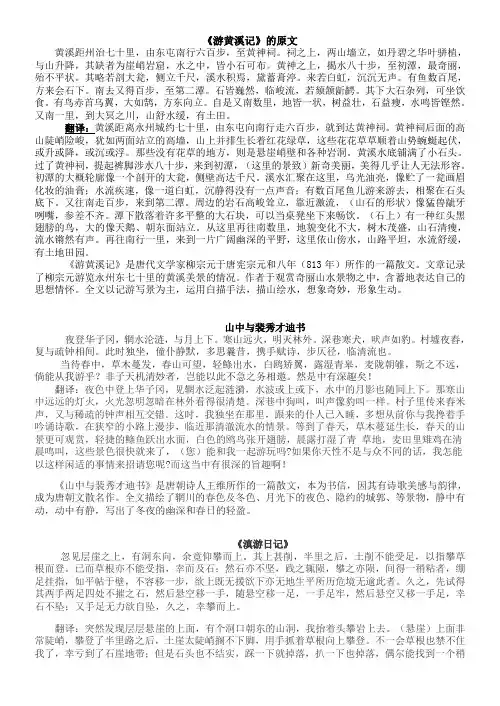
《游黄溪记》的原文黄溪距州治七十里,由东屯南行六百步,至黄神祠。
祠之上,两山墙立,如丹碧之华叶骈植,与山升降,其缺者为崖峭岩窟,水之中,皆小石可布。
黄神之上,揭水八十步,至初潭,最奇丽,殆不平状。
其略若剖大瓮,侧立千尺,溪水积焉,黛蓄膏渟。
来若白虹,沉沉无声。
有鱼数百尾,方来会石下。
南去又得百步,至第二潭。
石皆巍然,临峻流,若颏颔龂齶。
其下大石杂列,可坐饮食。
有鸟赤首乌翼,大如鹄,方东向立。
自是又南数里,地皆一状,树益壮,石益瘦,水鸣皆铿然。
又南一里,到大冥之川,山舒水缓,有土田。
翻译:黄溪距离永州城约七十里,由东屯向南行走六百步,就到达黄神祠。
黄神祠后面的高山陡峭险峻,犹如两面站立的高墙,山上并排生长着红花绿草,这些花花草草顺着山势蜿蜒起伏,或升或降,或沉或浮。
那些没有花草的地方,则是悬崖峭壁和各种岩洞。
黄溪水底铺满了小石头。
过了黄神祠,提起裤脚涉水八十步,来到初潭,(这里的景致)新奇美丽,美得几乎让人无法形容。
初潭的大概轮廓像一个剖开的大瓮,侧壁高达千尺。
溪水汇聚在这里,乌光油亮,像贮了一瓮画眉化妆的油膏;水流疾速,像一道白虹,沉静得没有一点声音;有数百尾鱼儿游来游去,相聚在石头底下。
又往南走百步,来到第二潭。
周边的岩石高峻耸立,靠近激流,(山石的形状)像猛兽龇牙咧嘴,参差不齐。
潭下散落着许多平整的大石块,可以当桌凳坐下来畅饮。
(石上)有一种红头黑翅膀的鸟,大的像天鹅、朝东面站立。
从这里再往南数里,地貌变化不大,树木茂盛,山石清瘦,流水锵然有声。
再往南行一里,来到一片广阔幽深的平野,这里依山傍水,山路平坦,水流舒缓,有土地田园。
《游黄溪记》是唐代文学家柳宗元于唐宪宗元和八年(813年)所作的一篇散文。
文章记录了柳宗元游览永州东七十里的黄溪美景的情况。
作者于观赏奇丽山水景物之中,含蓄地表达自己的思想情怀。
全文以记游写景为主,运用白描手法,描山绘水,想象奇妙,形象生动。
山中与裴秀才迪书夜登华子冈,辋水沦涟,与月上下。
六年级下册冀教版英语第二课课课堂笔记翻译[ti:unit 2 my favourite school subject lesson 9:don't be late for class!][0:01.]unit 2 第二单元[0:02.]my favourite school subject 我最喜欢的科目[0:06.]lesson 9: 第9课:[0:07.]don't be late for class! 听课不要耽误![0:11.]think about it![0:12.]·how many subjects do you study? what are they?[0:19.]·what's your favourite subject?[0:22.]·what subjects do jenny and brian like best?[0:29.]hi, jenny! 你好,珍妮![0:30.]hi, brian! 你好,布赖恩![0:31.]what class do you have next? 你接下来要上什么课?[0:33.]i have art next. 我接下来上美术课。
[0:35.]it's my favourite. 这是我最喜欢的。
[0:37.]i have painted six new pictures this week! 我这周已经图画了六幅崭新图画了![0:39.]i hope you'll show them to me sometime. 我希望有时间你能让我看看它们。
[0:42.]i have seen some of your paintings. 我曾经看见过你的一些画。
[0:44.]they're beautiful. 他们很漂亮。
[0:45.]i like art too, but i'm not very good at it. 我也讨厌美术,但是我不擅于。
Exercise 1 范例中国的传统节庆膳食是节日必不可少的伴侣。
例如,端午节(the Dragon Boat Festival)是纪念古代诗人屈原的日子。
那一天,人们通常要赛龙舟、吃粽子(zongzi)。
中秋节(the Mid-autumn Festival)是观赏满月的日子。
圆圆的月亮象征着圆满,象征着家庭团聚。
因此,中秋节的特制食品是一种圆形的月饼。
春节是中国的农历新年(the Chinese Lunar New Year),除了常见的家禽和肉类之外,人们还要按各自的地方习俗烹制传统食物,如饺子和年糕。
参考答案Traditional Chinese holiday meals are indispensable during festivals. For example, the Dragon Boat Festival is a day established in memory of the ancient poet Qu Yuan. People usually hold dragon boat races and eat zongzi (rice dumplings) on that day. The Mid-autumn Festival is an occasion for viewing the full moon, which is a symbol of perfection and family reunion. Therefore, the special food for this festival is a round cake called the moon cake. The Spring Festival is also known as the Chinese Lunar New Year. Besides/In addition to the common poultry and meat, people will also cook traditional food/foods, such as jiaozi (dumplings) and niangao (the Chinese New Year cake), according to their local customs.难点解析:1.中国的传统节庆膳食:翻译为traditional Chinese holiday meals,其中“节庆膳食”可译为holiday meals或holiday food,翻译时注意“中国的”和“传统的”顺序。
1.上课(Beginning a class)(1)Let’s start now./Let’s begin our class/lesson.(2)Stand up,please.(3)Sit down,Pease.2.问候(Greeting)(4)Hello,boys and girls/children.(5)Good morning,class/everyone/everybody/children/boys and girls.(6)Good afternoon,class/everyone/everybody/children/boys and girls.(7)How are you today?3.考勤(Checking attendance)(8)Who’s on duty today?/Who’s helping this morning/today?(9)Is everyone/everybody here/present?(10)Is anyone away?/Is anybody away?(11)Is anyone absent?/Is anybody absent?(12)Who’s absent?/Who’s away?(13)Where is he/she?(14)Try to be on time./Don’t be late next time.(15)Go back to your seat,please.(16)What day is it today?(17)What’s the date today?(18)What’s the weather like today?(19)What’s it like outside?4.宣布(Announcing)(20)Let’s start working./Let’s begin/start a new lesson./Let’s begin/start ourlesson.(21)First,let’s review/do some review.(22)What did we learn In the last lesson?(23)Who can tell/remember what we did In the last lesson/yesterday?(24)Now we’re going to do something new/different./Now let’s learn something new.(25)We have some now words/sentences.5.提起注意(Directing attention)(26)Ready?/Are you ready?(27)Did you get there?/Do you understand?(28)Is that clear?(29)Any volunteers?30)Do you know what to do?(31)Be quiet,please./Quiet,please.(32)Listen,please.(33)Listen carefully,please.(34)Listen to the tape recorder/the recording.(35)Look carefully,please.(36)Look over here.(37)Watch carefully.(38)Are your watching?(39)Please look at the black-board/picture/map…(40)Pay attention to your spelling/pronunciation.6.课堂活动(Classroom activities)(41)Start!/Start now.(42)Everybody together./All together.(43)Practise in a group./Practise In groups/In groups,please.(44)Get into groups of three/four…(45)Every body find a partner/friend.46)In pairs,please.(47)One at a time./Let’s do It one by one.(48)Now you,please./Your turn(Students name).(49)Next,please.Now you do the same,please.(50)Let’s act./Let’s act out/do the dialogue.(51)Who wants to be A?(52)Practise the dialogue,please.(53)Now Tom will be A,and the other half will be B.(54)Please take(play)the part of…(55)Whose turn is It?(56)It’s your turn. (57)Wait your turn,please.(58)Stand inline./Line up.(59)One by one./One at a time,please.(60)In twos./In pairs.(61)Don’t speak out.(62)Turn around.7.请求(Request)(63)Could you please try It again?(64)Could you please try the next one?(65)Will you please help me?8.鼓励(Encouraging)(66)Can you try?(67)Try,please.(68)Try your best./Do your best.(69)Think it over and try again.(70)Don’t be afraid/shy.9.指令(Issuing a command)(7)Say/Read after me,please.(72)Follow me,please.(73)Do what do.(7)Repeat,please./Repeat after me.(75)Once more,please./One more time,please.(7)Come here,please.(77)Please come to the front./Come up and write on the blackboard/chalkboard.(78)Come and write It on the blackboard.(79)Please go back to your seat.(80)In English,please.(81)Put your hand up,please.Raise your hand,please.(82)Put your hands down,please./Hands down,please.(83)Say it/Write it in Chinese/English.(84)Please take out your books.(85)Please open your books at page…/Find page…/Turn to Page…(86)Please answer the question/questions./Please answer my qllllst1On(s).(87)Please read this letter/word/sentence out loud./Please readout this letter/word/sentence.(88)Please stop now./Stop now,please./Stop here,please.(89)Clean up your desk/the classroom,please.(90)It’s clean-up time./Tidy up your desk/the classroom.(91)Put your things away./Clean off your desk./Pick up the scraps·(92)Clean the blackboard.(93)Plug in the tape-recorder,please.(94)Put the tape-recorder away.(95)Put the tap,In it’s box/cassette.(96)Listen and repeat.(97)Look and listen.(98)Repeat after me.(99)Follow the words.(100)Fast./Quickly!/Be quick,please.(101)Hurry!/Hurry up,please.(102)Slow down,please.(10)Slowly.(104)Bring me some chalk,please.10.禁止和警告(Prohibition and warning)(105)Stop talking./Stop talking now,please.(106)Don’t talk./Everybody quiet,please.(107)Don’t be silly.(108)Settle down.11.评价(109)Good,thank you.(10)Good/Very good./God job./Good work./Good example.(111)A good answer./Nice work.(112)Excellent./Great!/Well done./Very good./I like the way you(13)That’s Interesting(114)Don’t worry about It./No problem.(115)OK!/That’s OK.(116)I don’t think so.(117)That’s not quite right,any other answers?/That’s close/That’s almost right.(118)Not quite,can anyone help him/her?/try again.(119)A good try.12.布置作业(Setting homework)(120)For today’s homework…(121)Practise after class./Practise at home.(122)Say it out loud,before you write It down.(123)Copy/Print/Write each word twice.(124)Remember(Memorize)these words/sentences.(125)Learn these words/these sentences/this text by heart.(126)Do your homework./Do the next lesson./Do the new work.13.下课(Dismissing the class)(127)Hand in your workbooks,please.(128)Time is up.(129)The bell is ringing.(130)There’s the bell.(131)There goes the bell.(132)Let’s stop here.(133)That’s all for today.(134)Class is over.(135)Good bye./Bye./See you next time.。
作者: 张超 宋雪瑾
作者机构: 山东淄博师专附属中学,255100
出版物刊名: 中学教学参考
页码: 105-105页
年卷期: 2012年 第4期
主题词: 翻译技巧 英语课堂 中学 英汉语句 汉语翻译 英语初学者 英语翻译 思维转换
摘要:中学英语课堂上,常需要让学生将汉语翻译成英语,或者将英语翻译成汉语。
这种练习在培养学生英汉思维转换、培养学生造句能力方面会起很大作用。
但是英语初学者常常会把语句翻译得不准确。
“他太小而不能上学。
”学生常翻译
成“Heistoosmalltogotosch001.”“Mymotherisinhospital.”有的学生翻译成“我妈妈在医院。
”如何才能准确地翻译出英汉语句的意思呢?。
昔者,文山书海,文言文如巨浪滔天,卷起千层浪。
然今日之学子,多囿于白话文之泥沼,文言文之海洋,难以畅游。
是以,吾辈讲师,特设趣味文言文翻译课堂,以期激发学子兴趣,使文言文之魅力重现于世。
课堂之上,讲师笑谈:“夫文言文者,如古之佳人,含蓄温婉,韵味无穷。
然欲解其意,须得慧眼独具。
”遂命学子各取一篇文章,细细品味。
一学子手捧《庐山谣》,皱眉曰:“吾观此文,满纸荒唐言,一把辛酸泪。
不知何解?”讲师微笑曰:“此乃李白之作,言庐山之美,实则借景抒情。
汝可细读,体会其意境。
”学子稍作沉思,复曰:“吾解矣。
庐山谣云:‘日照香炉生紫烟,遥看瀑布挂前川。
’此句描绘庐山日出之景,美不胜收。
然‘飞流直下三千尺,疑是银河落九天’又言瀑布之壮观,如银河倾泻,令人叹为观止。
”讲师赞许道:“善哉,善哉!汝能领略此诗之美,可谓入门矣。
”遂引学子进入翻译之道。
一堂课下来,学子们纷纷捧出佳作。
一学子译《滕王阁序》云:“登高壮观天地间,大江茫茫去不还。
黄云万里动风色,白波九道流雪山。
”其文采斐然,令众学子羡慕不已。
讲师见状,戏言:“夫文言文,如酒,越品越有味。
今日汝等所译,虽略逊一筹,然已初露锋芒。
”学子们听罢,个个喜笑颜开。
课堂之余,讲师又设一游戏:“今夜月明人尽望,不知秋思落谁家?”学子们纷纷举手,欲一展身手。
一人曰:“举头望明月,低头思故乡。
”讲师击掌称赞:“妙哉!”又一学子曰:“月下独酌,对影成三人。
此时此刻,吾心飞扬,思乡之情油然而生。
”讲师笑曰:“此乃诗中有画,画中有诗。
汝能将二者结合,可谓文采飞扬。
”趣味文言文翻译课堂,不仅让学子们领略了文言文之美,更让他们在轻松愉快的氛围中,学会了如何翻译文言文。
一堂课下来,学子们纷纷感慨:“文言文,果然有趣!”时光荏苒,转眼间,学期将至尾声。
学子们纷纷告别趣味文言文翻译课堂,带着收获与喜悦,踏上新的征程。
而那课堂,依旧笑声不断,成为学子们心中永恒的回忆。
In 1644 AD, an ethnic minority living in prairie came down from the North. They got over the Great Wall and last arrived in Beijing. The Forbidden City, which is the symbol of imperial power (皇权), was occupied by the Manchurians (满洲里,满人).
公元1644年,一支来自北方的游牧民族开始南下,铁骑越过长城,直达北京。
象征着皇权的紫禁城落入了满族人之手。
The last dynasty in China history that is the Qing Dynasty began.
中国历史上最后一个帝国——大清,开始了。
More than half century later, a missionary(传教士)from Rome came to Guanzhou port first, which is in the south of China.
半个多世纪之后,一个来自罗马的传教士,达到了广州——大清帝国南方的港口。
He would go all the way up to the north to the capital of the imperial Beijing. Early in the 18 century, Chinese government strictly forbid the westerners …except the missionaries who are the messengers or the envoys of God.
他将从此北上,前往帝国的都城北京。
18世纪初期,帝国的统治者,严格禁止西方人进入中国冒险,只有上帝的使者,传教士例外。
The Church sent an Italy missionary whose Chinese name is 郎世宁. He was 28 years old at the time. He had never imaged that he would stay in China for totally 50 years.
耶稣会派往中国的传教士,28岁的意大利人郎世宁,根本没有想到,他将从此远离故土,在大清度过整整50年。
For almost half the century, this westerner witnessed the glory of the empire as well as the birth of this splendid royal garden with his unprecedented(空前的,绝无仅有的) opportunity.
半个世纪的时间,这个西方人以绝无仅有的机遇,见证了一个帝国的辉煌,也目睹了一座旷世园林的诞生。
This well-preserved correspondence between 郎世宁and the Church represented us a whole picture of his imaginary life in the court.
这些保留至今的传教士书信,记录了郎世宁在皇家宫廷的传奇生活。
We came all the way to gain/win the trust of Qing empire.
从欧洲到中国的旅行,花了整整一年的时间,一路风尘,就是为了取得大清皇帝的信任。
In the early morning /At dawn, a eunuch (太监) led us into a royal garden which was big and beautiful. We were not allowed to look around and we were told to walk silently.
天刚刚放亮,一个太监就带我们进了一座花园。
花园很大,但太监不许我们四处张望,走路也不能弄出声响。
I wondered why the emperor was not lived in the royal palace.
我很奇怪,皇帝并没有住在北京城里的皇宫。
The funders of Qing is ethnic Manchurian who were from the northeastern part of China where is
very cold. They soon found that though the palace is magnificent was actually not suitable for living.
大清的缔造者是满人。
他们来自中国北方的白山黑水。
紫禁城的新主人很快就发现,看上去宏伟壮丽的皇宫并不适合居住。
The palace which was made of wood was easy to get fire. Although the high wall could stop the fire from spreading, it also stopped the ventilation.
巨大的宫殿由木头建造,很容易着火。
高耸的宫墙虽然能够防止火灾的蔓延,也影响了空气的流通。
The summer of Beijing is hot and burning hot. The governors got used to the cool of north. So they found that the
北京的夏天酷热干燥,皇宫更像一个大火炉。
习惯于北方寒冷生活的统治者很不舒服。
Once they settled down in the Forbidden City, the emperor began to find the agreeable place.
从踏进紫禁城开始,皇帝就开始寻找凉爽宜人的地方。
In the northeast of Beijing over 20kilometers from Beijing city, there is an open-land called Haidian because there was full of springs a few hundreds years ago.
在北京的西北方向,距离皇宫20多公里有一片开阔地带。
几百年前,这里泉水遍布,成为海淀。
The third emperor of the Dynasty Kangxi built the detached palace (离宫). The first detached palace was built. This place Chang Chun Yuan, which Lang first met Kangxi.
就是在这儿,帝国的第三代统治者,康熙,终于建成一座离宫。
郎世宁就是在畅春园第一次看见了康熙皇帝。
The only purpose is to win the support of the emperor.
听说皇帝爱好天文,我们就从欧洲带来了最好的天文望远镜。
教会只有一个目的,就是希望得到皇帝的支持。
It turned out that the emperor Kangxi was very fond of it. Then an accident happened. Later, I knew the officer who was arrested in the court was related to the Crown Prince (皇太子)’rebellion against Kangxi.
康熙皇帝对我们的礼物果然很感兴趣。
但是,变故突然发生了。
后来我才知道,那个被当场抓走的军官与谋反的皇太子有关。